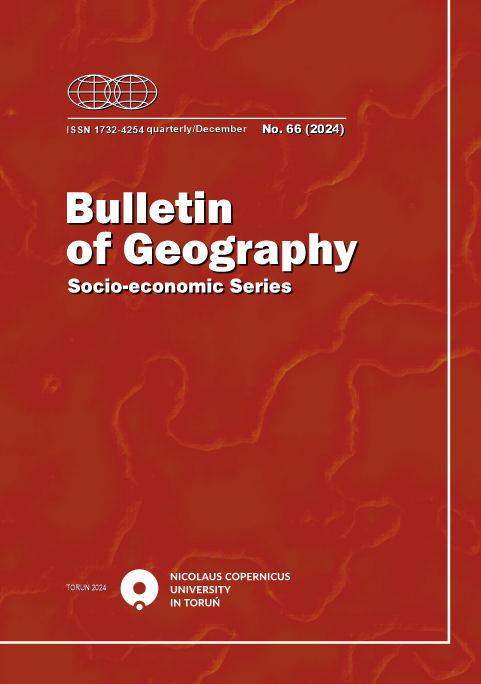Exploring spatial distribution of retail stores in South Korea
DOI:
https://doi.org/10.12775/bgeo-2024-0032Keywords
retail stores, geography, planning & development, clustering, spatial scale, L-function, variogramAbstract
In location decisions, retailers generally choose to cluster stores to capture more customers. This study examines the spatial distribution of retail stores in South Korea, and provides empirical guidelines for practitioners in urban planning and property management. Three areas representing urban, semi-urban, and rural regions were chosen for the study and analyzed using the L-function and variogram analysis, which are standard evaluation tools for geographical clustering. Stores such as private academies were found to be located close to each other at the shortest distance, followed by real-estate offices and sports equipment stores. The L-function analysis showed that stores were clustered within a distance of up to 2 km in Seoul, 6 km in Gyeonggi province, and 10 km in Gangwon province. In addition, the identified scales correspond approximately to the spatial dependence ranges of land prices. These results are expected to be utilized to design commercial zones in urban planning and delineate cluster boundaries.
References
Besag, J. (1977). Contribution to the discussion on Dr Ripley's paper. Journal of the Royal Statistical Society, 39: 193–195.
Besbes, O. & Sauré, D. (2016). Product assortment and price competition under multinomial logit demand. Production and Operations Management, 25(1): 114–127.
Blanchet, J., Gallego, G. & Goyal, V. (2016). A markov chain approximation to choice modeling. Operations Research, 64(4): 886–905.
Cabrera, J.G., Smith, N.R., Kalashinkov, V. & Cobas-Flores, E. (2009). Mathematical model for retail stores location in competitive environments. International Journal of Innovative Computing, Information and Control, 5(9): 2511–2521.
Caro, F., Martínez-de-Albéniz, V. & Rusmevichientong, P. (2014). The assortment packing problem: Multiperiod assortment planning for short-lived products. Management Science, 60(11): 2701–2721.
Chen, X., Song, Q. & Zhao, Z. (2020). Two-Player Location Game in a Closed-Loop Market with Quantity Competition. Complexity, 2020(1): 4325454.
Dixon, P.M., El-Shaarawi, A.H. & Piegorsch, W.W. (2012). Ripley’s K function. Encyclopedia of Environmetrics, 3: 1796–1803.
Duranton, G. & Overman, H.G. (2008). Exploring the detailed location patterns of UK manufacturing industries using microgeographic data. Journal of Regional Science, 48(1): 213–243.
Gómez-Hernández, J.J. (2005). Geostatistics. In: Hydrogeophysics. Springer, Dordrecht.
Grewal, D., Kopalle, P., Marmorstein, H. & Roggeveen, A.L. (2012). Does travel time to stores matter? The role of merchandise availability. Journal of Retailing, 88(3): 437–444.
Isaaks, E.H. & Srivastava, M.R. (1989). Applied geostatistics, 551.72 ISA.
Jang, M.S. (2015). Optimum location in spatial competition. Master’s Thesis. University of Seoul.
Jeong, D.S. & Kim, H.B. (2014). An analysis of the distribution and factors influencing sales by business types. GRI Review, 16(2): 101–122.
Konishi, H. (2005). Concentration of competing retail stores. Journal of Urban Economics, 58(3): 488–512.
Kosfeld, R., Eckey, H.F. & Lauridsen, J. (2011). Spatial point pattern analysis and industry concentration. The Annals of Regional Science, 47(2): 311–328.
Koster, H.R., Pasidis, I. & van Ommeren, J. (2019). Shopping externalities and retail concentration: Evidence from Dutch shopping streets. Journal of Urban Economics, 114: 103194.
Leclerc, F., Schmitt, B.H. & Dube, L. (1995). Waiting time and decision making: Is time like money? Journal of consumer research, 22(1): 110–119.
Netz, J.S. & Taylor, B.A. (2002). Maximum or minimum differentiation? Location patterns of retail outlets. Review of Economics and Statistics, 84(1): 162–175.
OECD, (2021). Education GPS. Available at: http://gpseducation.oecd.org (Accessed: 25 August 2022).
Okada, E.M. (2005). Justification effects on consumer choice of hedonic and utilitarian goods. Journal of marketing research, 42(1): 43–53.
Orr, A.M. & Stewart, J.L. (2022). Property use diversity and spatial accessibility within urban retailing centres: drivers of retail rents. Journal of Property Research, 39(4): 365–392.
Ossokina, I.V., Svitak, J. & Teulings, C.N. (2024). The urban economics of retail. Regional Science and Urban Economics, 104026.
Rodríguez Rangel, M.C., Sánchez Rivero, M. & Ramajo Hernández, J. (2020). A spatial analysis of intensity in tourism accommodation: An application for extremadura (Spain). Economies, 8(2): 28.
Rooderkerk, R.P., Van Heerde, H.J. & Bijmolt, T.H. (2013). Optimizing retail assortments. Marketing Science, 32(5): 699–715.
Rui, Y., Yang, Z., Qian, T., Khalid, S., Xia, N. & Wang, J. (2016). Network-constrained and category-based point pattern analysis for Suguo retail stores in Nanjing, China. International Journal of Geographical Information Science, 30(2): 186–199.
Saini, R., Rao, R.S. & Monga, A. (2010). Is that deal worth my time? The interactive effect of relative and referent thinking on willingness to seek a bargain. Journal of Marketing, 74(1): 34–48.
Tsoutsos, M.C. & Photis, Y.N. (2020). Spatial point pattern analysis of urban retail stores: the case of twelve large-and medium-sized Greek cities. European Journal of Geography, 11(4): 36–63.
Wang, F., Chen, C., Xiu, C. & Zhang, P. (2014). Location analysis of retail stores in Changchun, China: A street centrality perspective. Cities, 41: 54–63.
Yuo, T.S.T. & Tseng, T.A. (2021). The environmental product variety and retail rents on central urban shopping areas: A multi-stage spatial data mining method. Environment and Planning B: Urban Analytics and City Science, 48(8): 2167–2187.
Published
How to Cite
Issue
Section
License
Copyright (c) 2024 Changro Lee

This work is licensed under a Creative Commons Attribution-NoDerivatives 4.0 International License.
Title, logo and layout of journal Bulletin of Geography. Socio-economic Series are reserved trademarks of Bulletin of Geography. Socio-economic Series.Stats
Number of views and downloads: 333
Number of citations: 0



